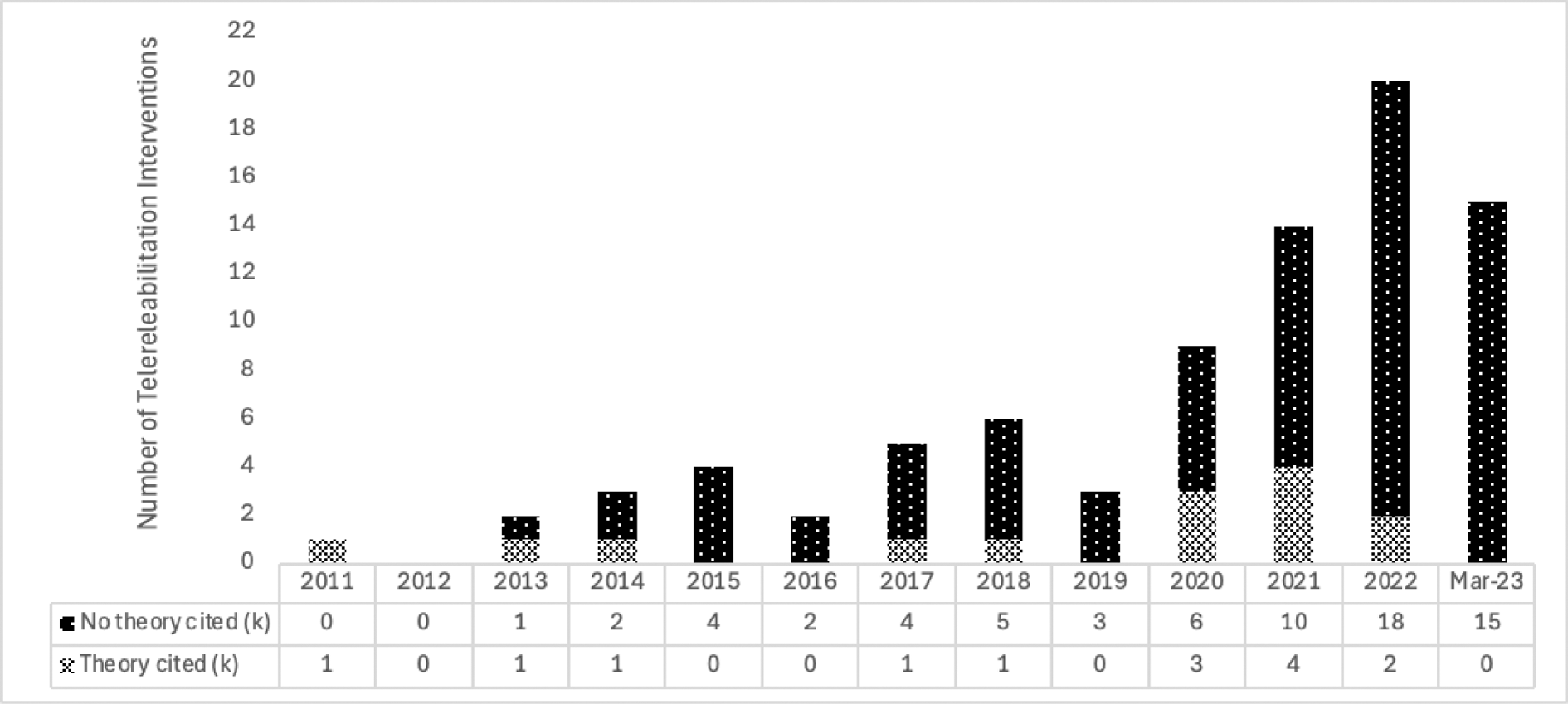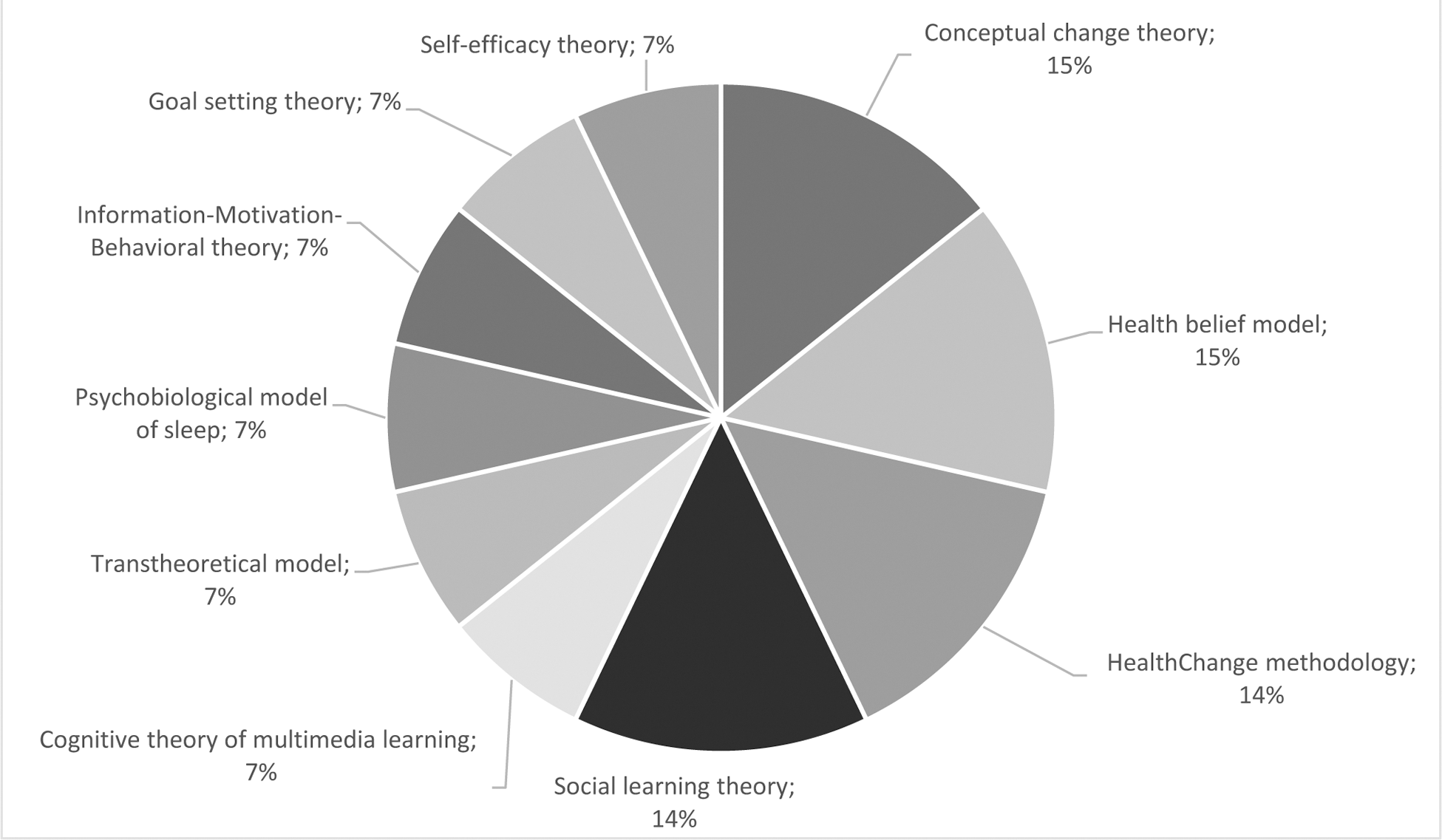

Background: Telerehabilitation is the provision of rehabilitation services using information and communication technology [1]. When used effectively telerehabilitation can be cost effective [2] and enhance the care of people living with rheumatic and musculoskeletal conditions (RMDs) [3]. The Medical Research Council framework for developing and evaluating complex interventions [4] highlights the importance of theory to maximise efficiency, use and impact. Yet, the recent rapid rise in telerehabilitation, enforced by the COVID-19 pandemic to address healthcare system pressures, may have meant that a systematic and theoretical approach to development may not have been possible. To ensure the best on-going quality of care for people living with RMDs, it is important to document the rise of telerehabilitation interventions and establish whether such services are being systematically developed and evaluated using theoretical frameworks.
Objectives: To identify yearly publication rates of telerehabilitation interventions to support people with RMDs. To identify the number of interventions citing the use of theoretical frameworks and document what theoretical frameworks are being employed.
Methods: Three electronic databases (Embase, Scopus, and Web of Science Core Collection) were searched between 2011 and March 2023. Peer-reviewed scientific publications were independently identified and screened for eligibility by two reviewers. Data were extracted on date published, population, and utilised theoretical frameworks. A narrative synthesis of evidence is presented. A protocol for this review has been registered on Figshare [5] and published [6].
Results: Searches up to March 2023 yielded 7,178 articles, of which 89 met the inclusion criteria with a further 31 articles included from hand searching reference lists. Of the 120 included articles, 84 unique telerehabilitation interventions were identified. The 84 telerehabilitation interventions targeted individuals diagnosed with knee osteoarthritis ( k = 41), rheumatoid arthritis ( k = 17), fibromyalgia ( k = 7), axial spondyloarthritis ( k = 5), systemic sclerosis ( k = 2), and systemic lupus erythematosus ( k = 3). Figure 1 reveals the number of publications by year and number of interventions that cite being informed by a theoretical framework. Most articles were published between 2020 and March 2023 ( k = 58), whereas few articles were published between 2011 and 2016 ( k = 12). A total of 14 of 84 studies (16.66%) cited a theoretical framework as informing the development of the telerehabilitation intervention. A fall in percentage of studies that cite being informed by theory occurs from 2020 (33%), with 29% in 2021, 10% in 2022 and 0% to March 2023. Across the 14 studies citing a theoretical framework, 10 different theories were identified (Figure 2). The HealthChange methodology, social learning theory, health belief model and conceptual change theory were each cited twice, the remaining theories were cited once. Seven interventions explicitly stated being informed by a behaviour change taxonomy. Despite this, goal setting was utilized in 34 interventions. Motivational interviewing was a technique employed in 15 interventions, 4 interventions employed cognitive behavioural therapy, and 4 interventions used the brief action planning framework.
Frequency of published telerehabilitation interventions by year with number citing a theoretical framework.

Theoretical frameworks cited by published telerehabilitation interventions (k =14).

Conclusion: A sharp rise in telerehabilitation interventions being published from 2020 was observed, and the majority do not report the use of theory. Despite the need for the rapid development of telerehabilitation interventions in response to the COVID-19 pandemic, it is important that the quality of RMD health care provision is maintained. In future, academics and health professionals should employ, and cite, theoretical frameworks to effectively develop, implement, evaluate, and maximise telerehabilitation intervention effects for people living with RMDs.
REFERENCES: [1] Brennan D, Tindall L, Theodoros D, Brown J, Campbell M, Christiana D, et al. A blueprint for telerehabilitation guidelines. Int J Telerehabil. 2010 Fall; 2(2):31-34.
[2] Baffert S, Hadouiri N, Fabron C, Burgy F, Cassany A, Kemoun G. Economic Evaluation of Telerehabilitation: Systematic Literature Review of Cost-Utility Studies. JMIR Rehabil Assist Technol. 2023 2023/9/5; 10:e47172.
[3] Amin J, Ahmad B, Amin S, Siddiqui AA, Alam MK. Rehabilitation Professional and Patient Satisfaction with Telerehabilitation of Musculoskeletal Disorders: A Systematic Review. BioMed Research International. 2022 2022/01/01; 2022(1):7366063.
[4] Skivington K, Matthews L, Simpson SA, Craig P, Baird J, Blazeby JM, et al. A new framework for developing and evaluating complex interventions: update of Medical Research Council guidance. BMJ. 2021; 374.
[5] Shakaib N, Barnett, R., Jones, S., Sengupta, R., and Rouse, P.C. Rehabilitation interventions delivered via telehealth to support self-management of rheumatic and musculoskeletal diseases: A scoping review protocol. Figshare. 2022.
[6] Barnett R, Shakaib N, Ingram TA, Jones S, Sengupta R, and Rouse, PC. Rehabilitation interventions delivered via telehealth to support self-management of rheumatic and musculoskeletal diseases: A scoping review protocol. PLoS One. 2024; 19(4):e0301668.
Acknowledgements: We acknowledge Dr Simon Jones and Nuzhat Shakaib for their input during the project.
Disclosure of Interests: Peter Rouse: None declared, Thomas Ingram: None declared, Rosemarie Barnett RB has worked as a paid consultant for Pfizer as a scientific writer, Raj Sengupta RS has received honoraria from Abbvie, Celltrion, Eli Lilly, Novartis, Pfizer, and UCB, RS has received grants from Abbvie, Celgene, Novartis, and UCB.
© The Authors 2025. This abstract is an open access article published in Annals of Rheumatic Diseases under the CC BY-NC-ND license (